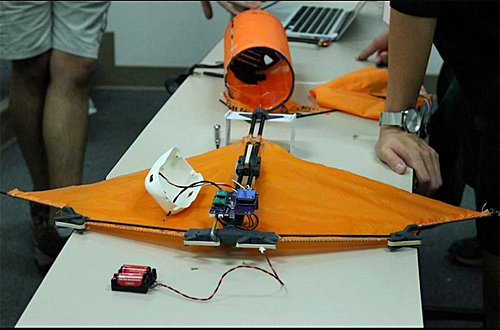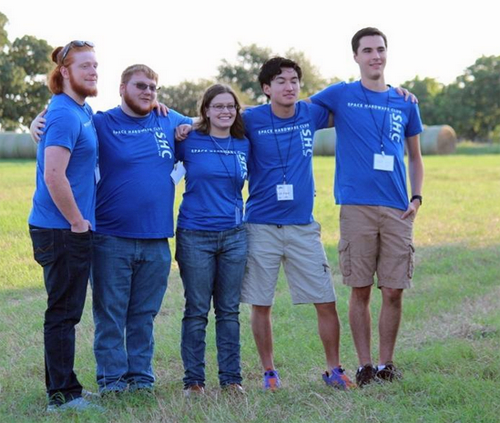
Members of the University of Alabama at Huntsville's Starscreamer team examines the solar powered glider as they get ready for the CanSat competition.
Photo is courtesy of the UAH Space Hardware Club.
The Gadsen Times' Dustin Fox posted a story reporting that, for most engineering fields, students have opportunities to take part in competitions that put their knowledge and education to the test — from building robots to remote controlled airplanes, these students practice what they have learned while receiving real-world training that will further their skills in the field.
Competitions for engineering fields dealing with space technology typically are restricted to theory and take place only on paper. For Owen Cox, an aeronautical engineering student at the University of Alabama at Huntsville, a CanSat competition in June gave his team a chance to experience the satisfaction of a hands-on engineering build.
CanSat, short for canned satellite, requires teams to build a satellite that is rocket launched in a canister that opens at the top of its launch to release a satellite that glides back to the Earth while collecting and transmitting atmospheric data. The team from UAH, which called themselves Starscreamer, consisted of Cox and eight others. The group began working on the project in November 2016, and after designing the satellite, the team submitted the schematics to CanSat for review. The organization chose the top 40 designs from around the world and those teams began the building process.

THe Starscream team, from left to right: Levi Cox, Jacob Herbertz, Claire Daly and Ryota Nakona, Thomas Bennet. Not pictured are John Bennet and Brenda Kimani.
Photo is courtesy of the UAH Space Hardware Club.
A 2016 graduate of Southside High School, Cox spent the majority of his freshman year at UAH working alongside his teammates building the device. - “It was like a second job,” Cox said. “I felt like I was flying on the seat of my pants trying to catch up." He added that many on the team had previous experience in high school.
Cox credits the AP courses he took in high school for instilling in him a work ethic and the knowledge of how to find out things he needed to learn to work alongside those teammates. That knowledge and work ethic helped Cox take on a role as head of the group working on the mechanics of the smallsat build. The team was split into separate groups that developed software, electrical, mechanical and ground station elements of the satellite. A recovery group also was established, which Cox worked on as well, to recover the satellite after its landing.
While leading the mechanics of the build, Cox worked to design and build prototypes for the glider before running tests to see how well those designs would perform in the sky. Designing and testing the device was only part of the experience. Members of the team took part in the entire process of an aerospace system.
To read the entire article, please access this direct link to the Gadsen Times...

